Blog categories
Blog archive
RSS Blog posts tagged with 'interior design'
Blog Filters
How To Decorate A Bedroom With Colours
Friday, November 20, 2020
We can all name at least one of our favourite colours, but not all of them are helpful for inducing comfort and relaxation in the bedroom.
While most of us may have strong opinions regarding our own favourite colours - or even a shade of someone else’s choice, there are universally understood implications associated with certain colours. Despite the many ways in which people differ, we generally agree that colours affect us in relatively predictable ways across most cultures.
 Interior design by: Bazarbayu
Interior design by: Bazarbayu
Consequently, saturating a bedroom in a favoured colour may not necessarily result in a space that is conducive for sleep, and the outcome may be a jarring décor that inadvertently induces less sleep. In this decorating guide, we take a closer look at the upsides and downsides of some of the most popular colour schemes and their effects on the psyche.
Earthy Terracotta
 Interior design by: Bazarbayu
Interior design by: Bazarbayu
Traditionally the preferred material for use in sculptures and the sun-baked rooftops of Mediterranean homes, terracotta is prized for the material’s association with antique works of art, but it still sees occasional use in affecting a rustic charm in modern spaces with warm and earthy tones. As a family of colours ranging from yellow to brown and resembling ancient fired clay, terracotta is complemented by neutral coloured backgrounds and softened by plush fabrics. Decorated by Bazerbayu, the pictured bedroom is saturated in a terracotta shade resembling sundried tomatoes, presented alongside rich textiles in a visually appealing balance against a neutral background.
Hello Yellow
 Interior design by: Nu Infinity
Interior design by: Nu Infinity
The noted sunflower enthusiast Vincent Van Gogh once remarked, “How wonderful yellow is. It stands for the sun." Yellow elicits creative impulses by evoking imagery of sunlight and summer blossoms, making the colour a welcome addition that enlivens and draws attention in neutral coloured bedrooms. But as with everything else in life, some moderation should be exercised as yellow implies heightened energy levels - and when overused, can lead to eye-strain, or even feelings of frustration in introverts. Decorated by Nu Infinity, the pictured bedroom demonstrates the invigorating effect of yellow when used as an accent in an otherwise plain space.
 Interior design by: Nu Infinity
Interior design by: Nu Infinity
Shades of Grey
 Interior design by: Surface R
Interior design by: Surface R
Out of all the colours that make up the neutral palette, grey is perhaps the most versatile - being capable of evoking buoyancy or gravity with slight adjustments in brightness. Light or dark, the use of grey provides a cooling shade that evokes a sense of space and blends easily in contemporary or minimalist interiors. In the pictured bedroom decorated by Surface R, subtle variations in grey are utilised to create the perception of depth and texture, with different shades of grey used in the fabrics of the space and special effects paints to portray brushstrokes on the wall.
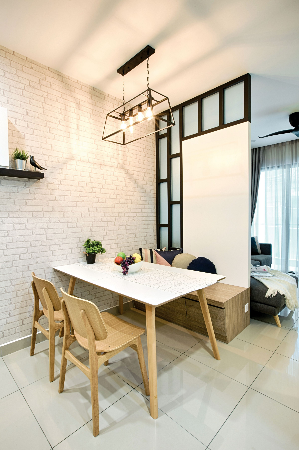
Top 30 Alternative Dining Interior Design Ideas
Friday, November 20, 2020
If you’re planning on squeezing a dining arrangement into a compact area, or combining spaces in an open layout, you may be interested in seeing some alternative arrangements that preserve a sense of airy volume. In this line-up of dining spaces, you will be treated to some ideas that rely on kitchen islands, wall-hugging furniture, or unconventional designs to provide some intriguing and unique results.
 A simplistic arrangement of Scandinavian design complements the neutral coloured decor and provides necessary seating without detracting from the openness of the space. Interior design by: GI Design
A simplistic arrangement of Scandinavian design complements the neutral coloured decor and provides necessary seating without detracting from the openness of the space. Interior design by: GI Design
 A noteworthy example of banquette seating arises from the centre of this open layout, with a decorative backing providing minimal segregation. Interior design by: Jashen Interior
A noteworthy example of banquette seating arises from the centre of this open layout, with a decorative backing providing minimal segregation. Interior design by: Jashen Interior
 With a bench in place of two chairs, this dining arrangement can be pushed closer to the wall to conserve space. Interior design by: Jashen Interior
With a bench in place of two chairs, this dining arrangement can be pushed closer to the wall to conserve space. Interior design by: Jashen Interior
 While the shape and size of the table surface has it projecting into the narrow space, a bit of demarcation around the perimeter reduces the prominence of the intrusion. Interior design by: Surface R
While the shape and size of the table surface has it projecting into the narrow space, a bit of demarcation around the perimeter reduces the prominence of the intrusion. Interior design by: Surface R
 The merging of the dining room and kitchen make for perhaps the most economical use of space. Interior design by: Yong Studio
The merging of the dining room and kitchen make for perhaps the most economical use of space. Interior design by: Yong Studio
 This combination of lightly treated wood, bare cement, aged leather, and patinated metal frames create a distinctly masculine space. Interior design by: X-Two Concept
This combination of lightly treated wood, bare cement, aged leather, and patinated metal frames create a distinctly masculine space. Interior design by: X-Two Concept
 This kitchen island features a broader-than-average surface that can be turned into a study table or dining table as needed. Interior design by: The Roof Studio
This kitchen island features a broader-than-average surface that can be turned into a study table or dining table as needed. Interior design by: The Roof Studio
 A projecting island surface is rendered less intrusive with the deliberate echoing of nearby architectural finishes and being made to appear as though it could be folded away. Interior design by: Mode Interior Style
A projecting island surface is rendered less intrusive with the deliberate echoing of nearby architectural finishes and being made to appear as though it could be folded away. Interior design by: Mode Interior Style
 Every component of this bar-height dining arrangement adheres to the requisite tones of the neutral palette in order to preserve a sense of space. Interior design by: Metrics Global
Every component of this bar-height dining arrangement adheres to the requisite tones of the neutral palette in order to preserve a sense of space. Interior design by: Metrics Global
 This kitchen features a diminutive country inspired nook, serving as a dining arrangement to seat up to four diners in close proximity within the compact confines of a standard kitchen. Interior design by: M Innovative Builders
This kitchen features a diminutive country inspired nook, serving as a dining arrangement to seat up to four diners in close proximity within the compact confines of a standard kitchen. Interior design by: M Innovative Builders
 This island serves as an implicit barrier to the kitchen and provides a place for guests to linger before heading into the chaos of the kitchen. Interior design by: M Innovative Builders
This island serves as an implicit barrier to the kitchen and provides a place for guests to linger before heading into the chaos of the kitchen. Interior design by: M Innovative Builders
 In the most compact of apartments, the placement of a dining table against one of the walls is almost a requirement for saving space. Designer: Konan Design
In the most compact of apartments, the placement of a dining table against one of the walls is almost a requirement for saving space. Designer: Konan Design
 While not the most appropriate or formal of dining arrangements, a bar provides a place for the casual consumption of a meal. Interior design by: Homlux Interior Furnishing
While not the most appropriate or formal of dining arrangements, a bar provides a place for the casual consumption of a meal. Interior design by: Homlux Interior Furnishing
 Rather than being relegated to the edges of the layout or being hidden in the kitchen, this bar occupies a central position in the foyer to serve as the primary attraction for arriving guests. Interior design by: Homlux Interior Furnishing
Rather than being relegated to the edges of the layout or being hidden in the kitchen, this bar occupies a central position in the foyer to serve as the primary attraction for arriving guests. Interior design by: Homlux Interior Furnishing
 Coloured in the same tones as the surrounding space, this kitchen island is camouflaged while serving as both a functional barrier and as an alternative dining surface. Interior design by: Gusto Design & Build
Coloured in the same tones as the surrounding space, this kitchen island is camouflaged while serving as both a functional barrier and as an alternative dining surface. Interior design by: Gusto Design & Build
 The trio of bar stools extend the reach of the reflective metals occurring at the edges of the space. Interior design by: Q1 Interior Concept
The trio of bar stools extend the reach of the reflective metals occurring at the edges of the space. Interior design by: Q1 Interior Concept
 In an inverse demonstration of the previous kitchen island, the thick and dark forms of these bar stools encapsulate the kitchen in a loose array of bold, black lines. Image Credit: Casa Indah Design
In an inverse demonstration of the previous kitchen island, the thick and dark forms of these bar stools encapsulate the kitchen in a loose array of bold, black lines. Image Credit: Casa Indah Design
 Against a monochromatic background of modern design, the sleek and angular design of these bar stools make the seating the main attractions of this kitchen. Interior design by: Q1 Interior Concept
Against a monochromatic background of modern design, the sleek and angular design of these bar stools make the seating the main attractions of this kitchen. Interior design by: Q1 Interior Concept
 A chabudai, or Japanese tea table, is perhaps the most intriguing form of furniture for an unconventional dining arrangement. Interior design by: Q1 Interior Concept
A chabudai, or Japanese tea table, is perhaps the most intriguing form of furniture for an unconventional dining arrangement. Interior design by: Q1 Interior Concept
 A favoured trope in modern interiors is the juxtaposition of gratuitous curves against a background of stark lines and monochromatic shades. Interior design by: Q1 Interior Concept
A favoured trope in modern interiors is the juxtaposition of gratuitous curves against a background of stark lines and monochromatic shades. Interior design by: Q1 Interior Concept
 A dining arrangement with the smallest footprint ever is formed out of a table that was apparently designed to be stowed when not in use. Image Credit: Nice-Style Refurbishment
A dining arrangement with the smallest footprint ever is formed out of a table that was apparently designed to be stowed when not in use. Image Credit: Nice-Style Refurbishment
 While the designs of furniture used in this arrangement are simplistic for the sake of preserving visual space, the application of both contrasting and unifying tones in accessories and upholstery arouses attention. Interior Design by: Nice Style Refurbishment
While the designs of furniture used in this arrangement are simplistic for the sake of preserving visual space, the application of both contrasting and unifying tones in accessories and upholstery arouses attention. Interior Design by: Nice Style Refurbishment
 The ubiquitous design of these bar stools enables the seating to blend into the background of monochrome and modern lines in the kitchen alcove. Interior design by: Jashen Interior
The ubiquitous design of these bar stools enables the seating to blend into the background of monochrome and modern lines in the kitchen alcove. Interior design by: Jashen Interior
 Another example of contemporary curves standing in front of a modern background is demonstrated with a highly limited set of materials in this kitchen. Image Credit: Design Spirits
Another example of contemporary curves standing in front of a modern background is demonstrated with a highly limited set of materials in this kitchen. Image Credit: Design Spirits
 As with many other arrangements where the kitchen island stands as a physical barrier, the stools here are selected for their potential to draw attention to the receiving face rather than the operative side of the kitchen. Interior design by: Homlux Interior Furnishing
As with many other arrangements where the kitchen island stands as a physical barrier, the stools here are selected for their potential to draw attention to the receiving face rather than the operative side of the kitchen. Interior design by: Homlux Interior Furnishing
 This arrangement puts modern lines and luxurious upholstery against a background of wood parquet in a herringbone pattern and classical wainscoting on walls. Interior design by: Bazarbayu
This arrangement puts modern lines and luxurious upholstery against a background of wood parquet in a herringbone pattern and classical wainscoting on walls. Interior design by: Bazarbayu
 This neutral coloured kitchen is wrapped in a bow of monochrome with glossy black being represented at the outer edges. Interior design by: Nu Infinity
This neutral coloured kitchen is wrapped in a bow of monochrome with glossy black being represented at the outer edges. Interior design by: Nu Infinity
 This dining arrangement utilises a kitchen island as a barrier to the kitchen, as well as the grounding element for the projecting dining surface. Interior design by: Nu Infinity
This dining arrangement utilises a kitchen island as a barrier to the kitchen, as well as the grounding element for the projecting dining surface. Interior design by: Nu Infinity
 This space demonstrates another small-footprint arrangement with a narrow shelf serving as a dining surface along the wall. Interior design by: Nu Infinity
This space demonstrates another small-footprint arrangement with a narrow shelf serving as a dining surface along the wall. Interior design by: Nu Infinity
 This kitchen island is made the main attraction of the open layout with the stark contrast between the bold, red upholstery and the neutral coloured architectural finishes. Interior design by: Space Living Interior Furnishing
This kitchen island is made the main attraction of the open layout with the stark contrast between the bold, red upholstery and the neutral coloured architectural finishes. Interior design by: Space Living Interior Furnishing
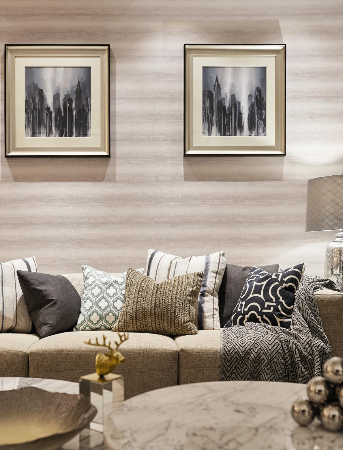
Styling With Patterns and Textures in Your Living Room
Friday, November 20, 2020
Through the use of fabrics, rugs, upholstery or solid surfaces, you can infuse a strong wow factor in your living room with patterns and textures.
Patterns and motifs add an immediate wow factor to living rooms - however they must be mixed and matched right. Whether you are introducing patterns and textures using fabrics, rugs, upholstery or solid surfaces, there are multitude ways to work with them to give your spaces their own unique personality.
 Interior design by: ST Concepts
Interior design by: ST Concepts
One of the key things to remember is that different patterns should have a common element so that they go together. It can be the same colour family, a similar style or complementing shapes. If you are doing this for the first time, the easiest way to ensure your different patterns go together is to use no more than 3 different motifs against a common palette.
Stay Neutral
 Interior design by: ST Concepts
Interior design by: ST Concepts
The neutral palette is a safe choice for a backdrop as it tends to bring a variety of patterns together without overwhelming the eye.
 Interior design by: ST Concepts
Interior design by: ST Concepts
In this living room, the designer successfully paired a variety of lush fabrics and textures together in a pleasing manner - thanks to the beige and off-white palette. To bring the eye to the furnishing pieces, pillows with geometric prints are used. Over on the feature wall, lines complement the decor while the polished marble surface of the coffee table gives the perfect finishing touch.
Pick a Hero Pattern
 Interior design by: Hoe & Yin Design Studio
Interior design by: Hoe & Yin Design Studio
Pick one pattern to be the hero, and use other patterns to complement it. The hero pattern can be something bolder and more dramatic. From here, it’s essential to create balance with more subtle prints or lighter colours.
 Interior design by: Hoe & Yin Design Studio
Interior design by: Hoe & Yin Design Studio
For this living room, a composition of interesting fabrics are used to create a lush effect. These fabrics serve as the complements for the hero feature in the room - the eye-catching wall-covering with two bright blue armchairs. The gray sofa and gray rug work well to offset the powerful patterns and tones used in this interior.
Mix Up the Textures
 Interior design by: Hoe & Yin Design Studio
Interior design by: Hoe & Yin Design Studio
Put different textures together to create an interesting ambience. Smooth surfaces can be softened up with cosy fabrics, while solid colours on the walls can be uplifted using flooring materials.
 Interior design by: Hoe & Yin Design Studio
Interior design by: Hoe & Yin Design Studio
This living room features a harmony of textures that blend in with the key furniture pieces. A single painting is effective in creating a secondary focal point while the addition of indoor plants also help to bring out a sense of freshness to the overall theme.
Tip: To find the perfect colour combo for your living room, use a colour wheel: hues that sit opposite each other on the sphere, like purple, orange, pink, and minty green, are guaranteed to look pretty when paired. And while bright shades can be exciting, remember that more neutral palettes have their own charm too.Repeat Motifs
 Interior design by: Surface R
Interior design by: Surface R
Using the same fabrics or textures may be monotonous, but when patterns are repeated, they can create a visual boost for your interior. If you are using a graphic pattern or something as simple as stripes, use it continuously within a single area to infuse your space with a focal point.
The partition is in this living room is the perfect example of using patterns in repetition. However, instead of just choosing a singular motif, the designer has gone for several similar motifs to create that patterned effect. What's interesting is the subtle addition of complementary prints in the form of pillows. There is also a second repetition of pattern on the wood finishing that envelopes the stairway.
[gallery link="none" columns="2" size="medium" ids="57465,57464"] Tip: When you want to shy away from bold and colourful patterns, texture is your best friend. Neutral is never boring when a variety of textures are used. Mix it up! Repeating the same pattern throughout a room is also a reliable way to achieve cohesiveness. Interior design by: Surface RGo Large
 Interior design by: Mode Interior Style
Interior design by: Mode Interior Style
If your living room is big and roomy, large-scale patterns are a good way to bring the space closer together. To avoid overpowering the interior with very strong patterns, use flooring so that it won’t visually steal attention away from your main furnishing pieces.
To introduce patterns, this home features a unique treatment of flooring styles. The laminate wood flooring is done up with irregular patterns that stand out prominently. To tone it down, smooth grey flooring is used next to it. The designer also added on a textural feature wall to create a distinctive focal point in this space.
Article by: Lily Wong
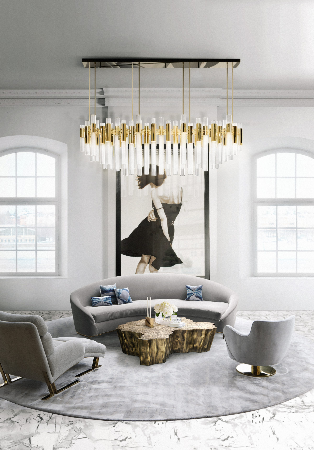
Living Room Lighting Ideas
Friday, November 20, 2020
Now that you have decided on your furnishings, it is time to think about putting your curation in a flattering light.
It would all be for naught, if you put in the time and effort to handpick your furnishings for a dramatic display in daylight - only for them to blend with the shadows when the sun sets. Unless the intended effect was a nocturnal disappearing act, you would want the results of your hard work displayed in full, attention-grabbing light for all to see. With the placement of a few thoughtfully-placed fixtures, even interiors that appear sombre in the evenings can be revitalised.
 Interior design by: Luxxu
Interior design by: Luxxu
While putting together your furniture arrangements, you may want to consider planning for lighting fixtures at the same time - as some forms of lighting require additional fixtures, wiring, or plasterwork in order to complete installations. In this guide, we take a closer look at the various forms of lighting available, their benefits, and the considerations that come with each.
Pendant Lights
 Interior design by: X-Two Concept
Interior design by: X-Two Concept
What minimalism has done to furniture can be seen in modern pendant lights - arguably the result of chandeliers being stripped of their trappings to retain the bare essentials in exposed bulbs. Pendant lights are most suited to modern and minimalist interiors, but are highly versatile with a wide range of styles due to their typically narrow profiles. The installation of pendant lights is not complicated by the weight of the fixtures, but rather by their typical composition in arrays of bulbs, requiring specialist wiring know-how to correctly chain bulbs together without running the risk of shorting out the electrical switchboard.
Spotlights
 Interior design by: Turn Design Interior
Interior design by: Turn Design Interior
For a dramatic cone of light around treasured decorations, consider installing a single spotlight with a narrow zone of effect directly overhead. The result is a gallery-like presentation that is better suited for highlighting specific objects rather than casting light over a wide area. For area effect lighting using spotlights, consider using a number of identical units arranged in a wide array, or selecting a set that includes a rail. Wiring considerations are similar to those for pendant lights, in that their installation is less often plug-and-play, more often requiring specialty adapters or dedicated wiring.
Wall Sconces
 Interior design by: GDY Design & Construction
Interior design by: GDY Design & Construction
Decorative lighting fixtures that are mounted to walls help to indirectly illuminate architectural finishes or to highlight decorative features nearby, however their placement is limited to points in a home where wiring has been provided. The installation of wall sconces, at least in locations that lack the requisite wiring points and corresponding switches, would entail the construction of wiring ducts along portions of walls - a process that typically results in a pervasive cloud of brick and concrete dust. If pre-existing conditions permit, consider using wall sconces in places where floor space is scarce.
Recessed Lighting
 Interior design by: Zids Design
Interior design by: Zids Design
One of the most subtly elegant ways to bestow a space with unobtrusive lighting is with LED strips embedded into the crevices and recesses of plaster ceilings. These lighting strips are typically used alongside white plaster ceilings as the pale surfaces serve to reflect light - in a manner very much like lampshades. The soft and indirect rays of light from recessed LEDs make for a low-profile fixture that blends well with styles ranging from classical to modern. The fixtures themselves are typically lightweight and uncomplicated to install, being made to plug into standard sockets - with the addition of adapters supplied by the manufacturers.
Chandeliers
 Interior design by: Design Integra
Interior design by: Design Integra
Even before electric lighting became a requisite household feature, crystal chandeliers have been used to suspend lighting sources high above the ground. The various crystal components are traditionally cut into specific designs to deliberately magnify and spread light out evenly across large spaces. Intricate crystal chandeliers of antique designs are still being used to appoint classically-inspired interiors, while newer offerings ranging in shape from modest to extravagant are better suited for more contemporary interiors. By virtue of their complicated construction, most chandeliers are hefty fixtures requiring the installation of ceiling hook plates to support the weight - meaning that the placement is limited to load-bearing beams or structural slabs rather than thin plaster ceilings.
Floor Lamps
 Interior design by: Sachi Interior Design
Interior design by: Sachi Interior Design
If you have the floor space to spare, floor lamps are ideal for casting light over a moderately wide area, working best in corners where the light they emit can be multiplied with the aid of pale or reflective surfaces. As floor lamps are not usually fixed, their positions can be changed to adapt with an evolving arrangement - and their production ensures that all is needed to power one is a domestic power outlet.
Table Lamps
 Tip: For a cohesive arrangement: select a table lamp that complements the space, providing a point where the materials and colours of the décor can converge. The pictured modern table lamps highlight the use of reflective metal accents and cream upholstery in the seating lounge, bringing the common materials to a corner of the space. Interior design by: SQFT Space Design Management
Tip: For a cohesive arrangement: select a table lamp that complements the space, providing a point where the materials and colours of the décor can converge. The pictured modern table lamps highlight the use of reflective metal accents and cream upholstery in the seating lounge, bringing the common materials to a corner of the space. Interior design by: SQFT Space Design Management
With an available table surface, a large portion of your lighting needs can be served with the simple placement of table lamp. Perhaps the most cost-effective solution for limited lighting, table lamps are often designed to act as decorative pieces on their own.
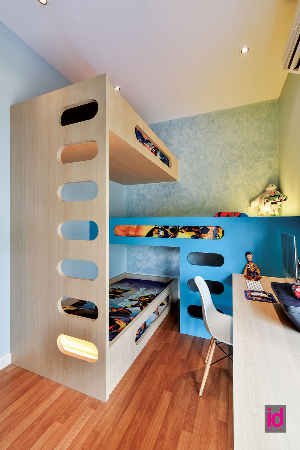
Playful Palettes: How to Create a Themed Bedroom for Boys
Friday, November 20, 2020
If you've read our tips on how to decorate bedrooms for children, you may also be interested in how to affect gender-specific themed decors for boys. We gathered our panel of interior designers to take a look at the composition of children's bedrooms and arrived at the following list of essential ingredients for a boy's themed bedroom.
Wall Colours The nautical theme is often the fall-back decor for most parents with young children, leading to the common use of various shades of blue to depict the sky and sea. Most boys bedrooms sport a palette dominated by blues, which work well as a background for a variety of animated characters.
 The walls of this bedroom are saturated in sky-blue, serving as a background for the figurines distributed about the space. Designer: Surface R
The walls of this bedroom are saturated in sky-blue, serving as a background for the figurines distributed about the space. Designer: Surface R
Bedspread The fabrics used on the bed can go a long way towards contributing to a theme by virtue of their size. Take special care to select a bedspread that is not only colourful, but also matches the other decorative features of the space in order to solidify a theme.
 The bedspreads are the sources of the most vivid colours in this bedroom, providing the most obvious indication of the occupants' genders. Designer: Q1 Interior Concept
The bedspreads are the sources of the most vivid colours in this bedroom, providing the most obvious indication of the occupants' genders. Designer: Q1 Interior ConceptMurals Perhaps the most definitive element of any themed bedroom is the central decorative element. Instead of using subtle lines and subdued colours as in adult bedrooms, consider instead a bright and colourful painted mural over the headboard to serve as the theme's centrepiece.
 This boy's bedroom embodies the superhero theme, combining various shades of blue in drapery and furnishings with characters from the Marvel Comics Universe above the fabric headboard, while images of DC Comics' Superman occupies the bedspreads. Designer: We Interior
This boy's bedroom embodies the superhero theme, combining various shades of blue in drapery and furnishings with characters from the Marvel Comics Universe above the fabric headboard, while images of DC Comics' Superman occupies the bedspreads. Designer: We Interior
Accessories Adding decorative accents to a boy's space can help bring the theme to a head. The usual accessories would be favoured toys, but more mature boys may prefer sports equipment or recreational facilities.

This room forgoes shades of blue entirely in favour of an energizing yellow. The sports theme is affected by the mural of a soccer player. Designer: Design Base
Storage Shelving can be made to fit particular themes in their designs, making it another viable point of focus when affecting a themed bedroom. Even at young ages, boys can pick up valuable life skills and train for adulthood while putting toys away and sitting down at desks for work.
 This bedroom includes shelving and a desk, complete with drawers for additional storage. Designer: Space Matrix
What about room for girls? Here are some tips.
This bedroom includes shelving and a desk, complete with drawers for additional storage. Designer: Space Matrix
What about room for girls? Here are some tips.
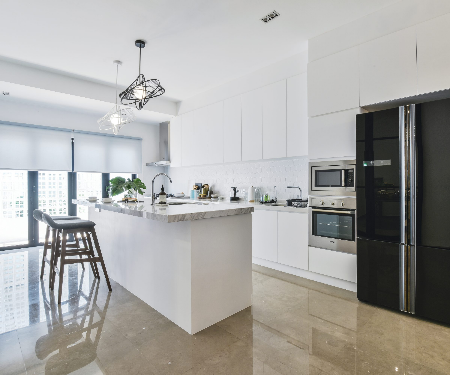
Designer Kitchen Lighting Tips
Friday, November 20, 2020
Don’t let the design of your kitchen be undermined by the shadows, light it up in the ways we describe here.
To say lighting is important is to condense the musings of all artists and designers into a single point of agreement that everyone can subscribe to. Light not only beautifies a space, but in a space as vital — and potentially chaotic — as the kitchen, light also serves as a practical consideration of safety and comfort.
 Interior design by: Yong Studio
Interior design by: Yong Studio
The pre-eminent architect who revolutionised the use of reinforced concrete and open floor plans, Charles-Édouard “Le Corbusier” Jeanneret, described light’s importance most aptly when nominating space, illumination, and order as being equally important as food and sleep in sustaining life. If you’ve planned and configured fixtures in the kitchen to your heart’s content, now would be the time we look into lighting the scene.
Natural Beauty
 Interior design by: Yong Studio
Interior design by: Yong Studio
To paraphrase the words of the late twentieth-century architect, Michael Graves: even panoramic beachfront views can become tiresome, but sunlight streaming into a room never gets old. In the insulated environments of modern convention, surrounded by tinted glass and blackout drapery, the powerful effects of sunlight often go under-appreciated. Yong Studio defies modern convention by opening up the pictured all-white kitchen to the skies with generous windows, appointing them with thin roller blinds to tame the glare of the tropical sun.
Layers of Light
Just as memorable works of art present nuanced blends of light and shadow, a well-lit kitchen requires multiple overlapping sources of light to colour the space, make manual tasks easier, and call attention to decorative features. In the pictured scene, Nine Plus Interior Design demonstrates an example of ideal lighting balance: the smooth white surfaces amplify the soft ambient lighting from the ceiling and the sunlit windows — widening the perception of this relatively compact space, while a hidden strip of light simultaneously draws the eye to the tiled backsplash and makes working on the countertops safer for fast-paced chefs.
 Interior design by: Nine Plus Interior Design
Interior design by: Nine Plus Interior Design
Tip: Light is a notoriously temperamental subject to control, but with a model bulb and accompanying lampshade one can go about testing effects while meticulously composing a visual scene as film directors do.
 Interior design by: Nine Plus Interior Design
Interior design by: Nine Plus Interior Design
Air of Elegance
 Interior design by: JCS Design Project
Interior design by: JCS Design Project
With all of one’s attention paid towards ensuring practical task lighting and orchestrating dramatic accent lighting, the consideration of subtle ambient lighting sometimes gets overlooked. Wide gaps between lighting sources contribute towards a darker space with the presence of shadows—but as demonstrated by JCS Design in the pictured kitchen—the addition of ambient lighting elevates the potential gloom to a soft sheen, providing for a considerably safer environment in which to manoeuvre around while handling hot cookery and cutting utensils.
Accent Aesthetics
 Interior design by: Nu Infinity
Interior design by: Nu Infinity
Even the most simplistic of spaces rendered monochromatic can be given a surprising measure of depth and dimension with the strategic placement of just a few accent lighting fixtures. With attention diverted to decorative features, a scene divides itself—with subtle elements shifting into background and highlighted features moving into the foreground of the composition. Nu Infinity imbues the pictured kitchen with depth by highlighting and transporting the wooden surface of the island counter to the visual foreground—using only a handful of hanging pendant lamps composed from a quality of wood to match and emphasise the island’s wooden surface.
 Interior design by: Nu Infinity
Interior design by: Nu Infinity
Tip: As with the preparation of any dish or concoction, adding more of a particular ingredient will provide greater emphasis for that particular flavour. In decorative terms, the preferred characteristics of a décor can be reinforced with the restrained sprinkling of a favoured texture, material, or colour.
 Interior design by: Nu Infinity
Interior design by: Nu Infinity
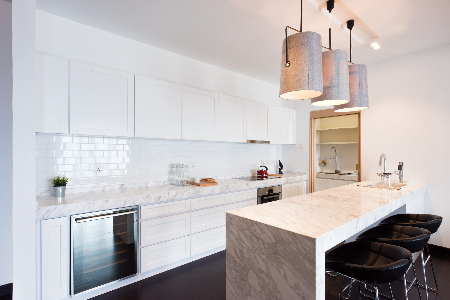
5 White Kitchen Ideas
Friday, November 20, 2020
A white kitchen is not just easier to keep clean; it can be made palatial with a nuanced blend of depth, texture, lighting, and accenting materials.
 Interior design by: Pocket Square
Interior design by: Pocket Square
Few have defined the colour white as aptly as Gilbert Chesterton, the “Prince of Paradox” and twentieth-century thinker who once said: “White is not a mere absence of colour; it is a shining and affirmative thing, as fierce as red, as definitive as black.” Beyond the trope of white representing purity — a factor that certainly sways the value of many homes—an all-white kitchen is easier to keep clean as stray spots of dirt are presented with greater contrast against an immaculate and white background. In light of all the benefits, a kitchen rendered in white is understandably the most popular method of dressing a cooking space, which is why we now take you on a tour of white kitchens.
Pristine Pose
 Interior design by: Pocket Square
Interior design by: Pocket Square
Much like the grains of natural wood, the organic veins of marble stand out with greater emphasis against a uniformly white background. But unlike common and readily available wood, the wide varieties of marbled stone speak volumes more of wealth and opulence—which is likely the reason why marble dining surfaces have been found to be highly prevalent in the homes, palaces, and places of worship in Ancient Greek and Roman society. The designers of the pictured kitchen demonstrate the regal effects of a pale marble, echoing the smooth white cabinetry and the pale wood accents against the monochromatic background.
Pure Touch
 Interior design by: Yong Studio
Interior design by: Yong Studio
A featureless space does little to comfort — as described in fiction, the appearance of a room devoid of any detail represents a frightening and disorientating detachment from reality. With some varying sensations of depth and texture incorporated into an all-white space, even a matte-white background will come alive with a range of stimuli to invite an exploratory touch.
As Yong Studio demonstrates in the pictured cooking space, a distinct transition from the smooth cabinet doors to the brick-configuration of tiles on the backsplash provides the scene with some variations in texture to beguile minds perpetually in search of familiar details.
 Interior design by: Yong Studio
Interior design by: Yong Studio
Finer Details
 Interior design by: Latitude Design
Interior design by: Latitude Design
A kitchen saturated in white does not necessarily have to appear as a flat and featureless space. Attention-grabbing details can be weaved into an all-white kitchen with decorative features painted to match and emphasise the white background. Latitude Design pulls the pictured cooking space from the brink of monotony by adding white cabinet doors adorned with intricate wainscoting and table legs decorated with ornately carved floral motifs. The result is a classically inspired and luxuriously uplifting décor seemingly transported from a stately cottage in the French countryside.
 Interior design by: Latitude Design
Interior design by: Latitude Design
Tip: A simplistic array of lines and textures provides even the most monochromatic of spaces with a measure of visual depth, but when attempting to adhere to a particular decorative style, the details should conform to the unwritten rules of the theme – such as the requirement for intricate ornamentation in classically inspired spaces.
 Interior design by: Latitude Design
Interior design by: Latitude Design
Wood Attitude
 Interior design by: Gusto Design
Interior design by: Gusto Design
Without an array of details to provide the space with variations in texture, an all-white kitchen relegates itself to serve as a background. Against this uniform background of white, a focal point of wood creates a scene of striking visual contrast and draws the observer into the space.
 Interior design by: Gusto Design
Interior design by: Gusto Design
Gusto Design purposefully incorporates few details into the pictured kitchen, enabling attention to instead fall to the slab of lightly treated wood poised at the centre of the space. For emphasis, a trio of disparate pendant lamps are hung directly over the focal point to further drive attention to the kitchen island.
[gallery columns="2" size="medium" link="file" ids="60801,60804"] Interior design by: Gusto DesignLight Bright
 Interior design by: Yong Studio
Interior design by: Yong Studio
With white being composed of all the other colours along the visible spectrum of light, surfaces painted white are exceedingly adept at faithfully echoing the tone of light reflecting off them.
 Interior design by: Yong Studio
Interior design by: Yong Studio
Yong Studio soaks the white background of the pictured kitchen with a combination of yellow light cast by hanging pendant lamps, ample natural sunlight via wide patio doors, in addition to wood flooring and countertops. The result is a warm and comfortingly familiar sheen that permeates the space, varying between slightly off-white and pale flesh tones depending on the perspective of the observer.
 Interior design by: Yong Studio
Interior design by: Yong Studio
Tip: White being the most reflective of colours, an all-white space will take on various other tones through the course of the day – reflecting light and adjacent colours with often mystical and unpredictable results.
 Interior design by: Yong Studio
Interior design by: Yong Studio
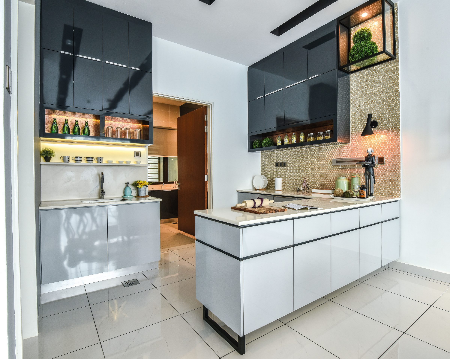
Top 30 Kitchen Interior Design Ideas in Malaysia
Friday, November 20, 2020
If you're decided on your preferred colours, materials, and configurations for the kitchen, you may also be interested in getting your regular dose of inspiration with these 30 exemplar cooking spaces.
 This kitchen is brought from simplistic monochrome and into neutral territory with the rendition of a backsplash in beige hexagonal tiles. Interior design by: Homlux Interior Furnishing
This kitchen is brought from simplistic monochrome and into neutral territory with the rendition of a backsplash in beige hexagonal tiles. Interior design by: Homlux Interior Furnishing
 In contrast to the rest of the home, this kitchen is almost entirely saturated in white and black to give emphasis to the neutral coloured surroundings. Interior design by: Moonlit Inspiration
In contrast to the rest of the home, this kitchen is almost entirely saturated in white and black to give emphasis to the neutral coloured surroundings. Interior design by: Moonlit Inspiration
 A case for decorating with accessories is made in this nearly all-white kitchen, with a range of books and jars of spices providing bright splashes of colour for intriguing contrast. Interior design by: IDS Interior
A case for decorating with accessories is made in this nearly all-white kitchen, with a range of books and jars of spices providing bright splashes of colour for intriguing contrast. Interior design by: IDS Interior
 This neutral coloured kitchen serves as an unobtrusive backdrop for the iconic Snowball pendant by Louis Poulsen and the pair of countryside-inspired bar stools. Interior design by: PSQ
This neutral coloured kitchen serves as an unobtrusive backdrop for the iconic Snowball pendant by Louis Poulsen and the pair of countryside-inspired bar stools. Interior design by: PSQ
 A rendition of a rural cooking space is achieved with a coffered ceiling and darkly stained wood for cabinets. Interior design by: Q1 Interior Concept
A rendition of a rural cooking space is achieved with a coffered ceiling and darkly stained wood for cabinets. Interior design by: Q1 Interior Concept
 Rather than leaving this kitchen white and utilitarian, the designer opts for the injection of colour via yellow trim around selected shelves, in addition to bench upholstery and a backsplash rendered in a matching shade of indigo. Interior design by: Zids Design
Rather than leaving this kitchen white and utilitarian, the designer opts for the injection of colour via yellow trim around selected shelves, in addition to bench upholstery and a backsplash rendered in a matching shade of indigo. Interior design by: Zids Design
 What would have been a utilitarian and all-white kitchen is instead given some unique character with the use of patinated stone on the floors and backsplash. Interior design by: Craftsmen Valley
What would have been a utilitarian and all-white kitchen is instead given some unique character with the use of patinated stone on the floors and backsplash. Interior design by: Craftsmen Valley
 Stark lines of darkly stained wood and steel converge in this kitchen to create a cooking space that is simultaneously modern, yet rustic and industrial. Interior design by: Luna Solutions
Stark lines of darkly stained wood and steel converge in this kitchen to create a cooking space that is simultaneously modern, yet rustic and industrial. Interior design by: Luna Solutions
 The unadulterated grains of natural wood are utilised to paint this space with intriguing and irreproducible lines. Interior design by: Nu Infinity
The unadulterated grains of natural wood are utilised to paint this space with intriguing and irreproducible lines. Interior design by: Nu Infinity
 A slab of dramatically veined marble elevates this modern classic kitchen to the height of luxury and adds a layer of organic lines over the stringent décor. Interior design by: FIX Design Solution
A slab of dramatically veined marble elevates this modern classic kitchen to the height of luxury and adds a layer of organic lines over the stringent décor. Interior design by: FIX Design Solution
 A fine balance between austere and opulent is struck in this kitchen, with dark wood serving as a rustic element while the backsplash speaks of luxury with a near-seamless panel of marble. Interior design by: Global Elite Ventures
A fine balance between austere and opulent is struck in this kitchen, with dark wood serving as a rustic element while the backsplash speaks of luxury with a near-seamless panel of marble. Interior design by: Global Elite Ventures
 The use of reflective metals in this kitchen serves the dual purpose of camouflaging the appliances and adding a layer of luxury to the monochromatic space. Interior design by: GDY Design & Construction
The use of reflective metals in this kitchen serves the dual purpose of camouflaging the appliances and adding a layer of luxury to the monochromatic space. Interior design by: GDY Design & Construction
 This kitchen demonstrates one of the least often seen applications of a kitchen island – as an alternative dining surface and a teppanyaki style stove-top simultaneously. Interior design by: Living Space Creative Design
This kitchen demonstrates one of the least often seen applications of a kitchen island – as an alternative dining surface and a teppanyaki style stove-top simultaneously. Interior design by: Living Space Creative Design
 While typical kitchens are sequestered behind corners and closed doors, this dry kitchen sits in full view as part of an open layout. Interior design by: D'concepto Design
While typical kitchens are sequestered behind corners and closed doors, this dry kitchen sits in full view as part of an open layout. Interior design by: D'concepto Design
 The hallmarks of several historical styles converge in this kitchen, along with an abundance of reflective metals and glossy white tiles on the backsplash for a measure of modern flavour. Interior design by: ST Concepts
The hallmarks of several historical styles converge in this kitchen, along with an abundance of reflective metals and glossy white tiles on the backsplash for a measure of modern flavour. Interior design by: ST Concepts
 A kitchen decorated in rustic industrial style almost requires a striking centrepiece – such as the pictured retro-style fridge from Smeg. Interior design by: Yong Studio
A kitchen decorated in rustic industrial style almost requires a striking centrepiece – such as the pictured retro-style fridge from Smeg. Interior design by: Yong Studio
 Another alternative to hiding the kitchen is demonstrated with glass partition walls atop a border of countertops. Interior design by: SQFT Space Design Management
Another alternative to hiding the kitchen is demonstrated with glass partition walls atop a border of countertops. Interior design by: SQFT Space Design Management
 Composed largely from various tones of wood, this neutral coloured cooking space is given a bit of mirthful colour for an uplifting result. Interior design by: Blaine Robert Design
Composed largely from various tones of wood, this neutral coloured cooking space is given a bit of mirthful colour for an uplifting result. Interior design by: Blaine Robert Design
 Several disparate tones of wood are utilised to accent this all-white kitchen and provide the space with some visual depth. Interior design by: PSQ
Several disparate tones of wood are utilised to accent this all-white kitchen and provide the space with some visual depth. Interior design by: PSQ
 In a departure from the norm, this cooking space embraces its relegation to the outer edges of the home with a practical and intriguing aperture in the wall. Interior design by: Design Spirits
In a departure from the norm, this cooking space embraces its relegation to the outer edges of the home with a practical and intriguing aperture in the wall. Interior design by: Design Spirits
 As with any other monochromatic space, the introduction of a single additional colour provides a some appealing visual complexity. Interior design by: One Roof Kitchen
As with any other monochromatic space, the introduction of a single additional colour provides a some appealing visual complexity. Interior design by: One Roof Kitchen
 This rural-styled kitchen is made memorable with the saturation of its cabinets and countertops in a rarely seen colour – a regal shade of green. Interior design by: Latitude Design
This rural-styled kitchen is made memorable with the saturation of its cabinets and countertops in a rarely seen colour – a regal shade of green. Interior design by: Latitude Design
 A specular quality of stone on the countertops, in addition to a similar motif in the tile mosaic of the backsplash, provide this pale kitchen with a subtle dose of texture. Interior design by: Archint Design
A specular quality of stone on the countertops, in addition to a similar motif in the tile mosaic of the backsplash, provide this pale kitchen with a subtle dose of texture. Interior design by: Archint Design
 This kitchen demonstrates another variation of speckled motif rendered in tile mosaic, this time to reinforce a monochromatic colour theme. Interior design by: GDY Design & Construction
This kitchen demonstrates another variation of speckled motif rendered in tile mosaic, this time to reinforce a monochromatic colour theme. Interior design by: GDY Design & Construction
 Elegance arising from simplicity is demonstrated using nothing more than the requisite neutral palette and straight lines of modern design. Interior design by: Nu Infinity
Elegance arising from simplicity is demonstrated using nothing more than the requisite neutral palette and straight lines of modern design. Interior design by: Nu Infinity
 Nearly devoid of texture, this kitchen's all-white decor is a deliberate choice made to preserve the perceived width of the space. Interior design by: Deep White Design
Nearly devoid of texture, this kitchen's all-white decor is a deliberate choice made to preserve the perceived width of the space. Interior design by: Deep White Design
 The grains of wood are used to accent this all-white kitchen and unify the space with the neutral coloured décor in the remainder of the home. Interior design by: Architrio design
The grains of wood are used to accent this all-white kitchen and unify the space with the neutral coloured décor in the remainder of the home. Interior design by: Architrio design
 In conjunction with the near-complete saturation in white, adjacent planes are kept glossy and reflective to widen the space. Interior design by: Jashen Interior Design
In conjunction with the near-complete saturation in white, adjacent planes are kept glossy and reflective to widen the space. Interior design by: Jashen Interior Design
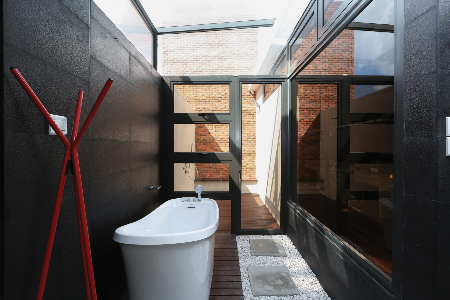
2018's Top Bathroom Trends
Friday, November 20, 2020
With the larger half of the year behind us, we take a look at the most intriguing and luxurious decorative trends emerging in bathrooms.
A bathroom may be just that to most, but the most highly prized homes make a masterpiece of every space. If you are seeking to imbue your washrooms with greater value, look beyond what bathrooms should look like and seek inspiration in the trends that have evolved so far. With just over half the year in the bag, there has been a deluge of data from which we were able to discern this year’s progression of trends, and among the notable features what we have seen are encouraging pursuits of natural light, commendable efforts to maximise decorative potential with the very minimum of materials, in addition to some bold experimentations with colours beyond utilitarian white.
Glass Box
 Interior design by: Nu Infinity
Interior design by: Nu Infinity
A bathroom that receives abundant sunlight during the day remains pleasant as it dries up faster – and there is nothing that dependably keeps a space hygienic like a regular wash of free ultraviolet light. But for a space that requires privacy as the average bathroom does, there is a tendency for few exterior windows providing natural light. In the course of this half year, we have seen a resurgence of bathroom fixtures boldly thrust into the sunlight by way of generous glass boxes, exterior windows, and skylights – as demonstrated in the pictured bathroom designed by Nu Infinity.
Earthy Enigma
Ordinary spaces rapidly fade from memory, while a boldly coloured space will often be remembered and known by its predominant shade. It takes a certain kind of bravery to experiment with colours beyond the confines of normalcy, especially with the results often literally set in stone, but striking uses of colour can elevate ordinary bathrooms to works of art. While the majority of bathrooms we have seen remain predominantly white for practical reasons, we have also come across some shining examples of earthy colours taking the lead – such as the desert beige tone of the pictured bathroom tiled in terracotta.
[gallery columns="2" link="file" size="medium" ids="60778,60779,60777,60776"] Interior design by: USPA EuropeTip: While the colour white is a practical choice for spaces where cleanliness is paramount, an all-white bathroom represents a missed opportunity to express oneself. Treat every plane as a canvas to be painted and you’ll end up with a truly memorable and unique bathroom.
Material Variety
Well-known pieces of art are often valued more for the sum of their parts than for the presence of any particular detail – and with that in mind, one could paint an attractive space with disparate materials held in a balanced composition. If conservation is the guiding principle, or if adequate supplies of a matching variety of tile are lacking, consider some unspoken codes of aesthetics – such as the rule of threes, as expressed in the pictured bathroom. The designers, ID Industries, opted for no more than three sets of tiles to paint this bathroom with inviting contrast and intriguing demarcation.
[gallery columns="2" size="large" link="file" ids="60773,60774"] Interior design by: ID IndustriesTip: All materials provide a measure of colour and texture, but the contrasts don’t just end there. The styles and themes of wall treatments can also be combined to result in truly unique statements.
Dark Beauty
 Interior design by: Maison Valentina
Interior design by: Maison Valentina
It is often said that style is cyclical – a sentiment that foretells of a return to the sombre and dark aesthetics of the roaring 1920s, an era that saw heights of prosperity unmatched until recent years. Directly contradicting the prevailing shade of modern bathrooms, a dark washroom speaks of a quality of elegance and luxury that is inherently masculine and still largely uncommon in the present age. If you are seeking to craft a truly unique bathroom, look to the dark side, as demonstrated by Maison Valentina, a luxury provider of high-end bathroom fixtures.
 Interior design by: Maison Valentina
Interior design by: Maison Valentina
Tip: A dark décor typically benefits from limited doses of gilded metals and directed light to provide the space with a luxurious sheen.
 Interior design by: Maison Valentina
Interior design by: Maison Valentina
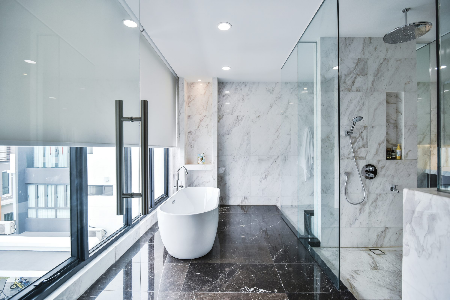
5 Bathroom Tile Trends
Friday, November 20, 2020
An ordinary bathroom can be made memorable and luxurious with some exploratory whimsy, outside-the-box thinking, and the bravery to try something different.
In the immortal words of Francis Bacon — the father of modern scientific methodology: “Nothing is pleasant that is not spiced with variety.” So if you are in the midst of redecorating your bathroom, you may be interested in considering some convention-defying ways of rendering tiles to imbue the space with awe inspiring characteristics rather than hiding it from sight.
 Interior design by: Alpex Design
Interior design by: Alpex Design
If you feel inclined to do more than create a utilitarian bathroom entirely in white, then this decorative guide is for you. In this guide, we take a closer look at a range of bathrooms made memorable with unique colours and luxurious with decorative features to draw attention.
Vein Reign
 Interior design by: Alpex Design
Interior design by: Alpex Design
As with other parts of the home, the addition of marbled stone surfaces bestows bathrooms with irreproducible and overt symbols of opulence. While the simplistic colour palette of the pictured bathroom would have it categorised as monochromatic from afar, Alpex Design elevates the monotonous space to the height of luxury with near-seamless slabs of white Carrara marble and black Nero Marquina in close proximity for striking contrast. The standard white fixtures, and the accessories that have been selected to match, stand with deliberately reduced prominence when blending in with the wispy grey veins of the white marble in the background.
Duo Tone
 Interior design by: Bathroom Takeaway
Interior design by: Bathroom Takeaway
One of the longest-surviving hallmarks of classical design is the ubiquitous chair rail, and while tradition implies that the chair rail should accompany seating furniture, the application of subtle delineation at the height of a standard chair rail creates a unique scene that would draw the attention of the artful eye. The horizontal dividing line separates the walls into upper and lower fields, with the upper field of the wall painted pink and the lower field rendered in black to accompany the white fixtures against the monochromatic floor.
 Interior design by: Bathroom Takeaway
Interior design by: Bathroom Takeaway
Tip: Being a characteristic feature of traditional décor, the standard chair rail blends well with other hallmarks of classical style such as wainscoting to walls, gilded metals, and other intricate embellishments.
 Interior design by: Bathroom Takeaway
Interior design by: Bathroom Takeaway
Pattern Play
 Interior design by: GI Design
Interior design by: GI Design
Just as with a blank white canvas, any neutral-coloured space will eventually serve as the backdrop for intriguing motifs and visually striking elements presented in the scene. As in the pictured bathroom decorated by GI Design, a jigsaw puzzle motif stands out by relying on the off-white tiles and pale wood flooring that constitute the background. Despite being composed from interconnected pieces that range in colour from a matching shade of white through to dark grey, the curved lines and various greys immediately draw the eye to the far wall of the bathroom.
Hue Renew
 Interior design by: Boundary Space
Interior design by: Boundary Space
While most bathrooms may feature an all-white décor for space-expanding effects and effortless maintenance, few bathrooms are as memorable as those rendered in unconventional tones. A bold accent in a neutral-coloured space can have striking and memorable effects, as demonstrated in the pictured bathroom designed by Boundary Space, where grey and white marble enclose fixtures and accents soaked in an avocado’s shade of green. In combination with the faint grey veins of the white marble and the gilded metallic elements, the unique shade of green renders the space mature and regal.
 Interior design by: Boundary Space
Interior design by: Boundary Space
Tip: Adhering to the guideline we sometimes refer to as the “rule of threes” ensures that colours normally considered to be disparate and contrasting will be held in an even balance.
 Interior design by: Boundary Space
Interior design by: Boundary Space
Good Divide
 Interior design by: Q1 Interior Concept
Interior design by: Q1 Interior Concept
In a space as compact as the typical bathroom, physical demarcation can be served by a limited set of fixtures entailing customised metal frames and glass panes, or simply with a contrasting choice of tiles to preserve a sense of volume. Rather than opting for an intrusive glass curtain wall around the shower area, Q1 Interior Concept incorporates a darker variety of stone tiles for high-contrast delineation against the pale walls and floors of the pictured bathroom. The result is a bathroom that is kept physically spacious, with only a slight reduction in perceived space evoked by the dark accent.





